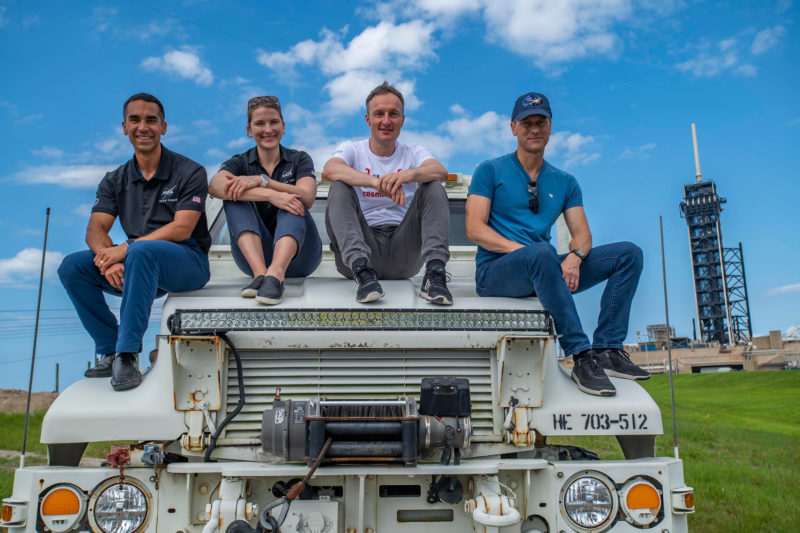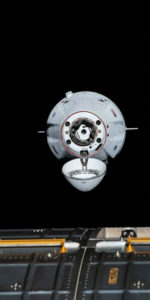
Four astronauts representing NASA and the European Space Agency (ESA) are only three weeks away from their 2:43 a.m. EST launch on 30 October to the International Space Station (ISS). Seasoned spacefarer Tom Marshburn—a veteran of two prior missions and only the second American to have flown the shuttle, Soyuz and Crew Dragon—will be accompanied by “rookies” Raja Chari and Kayla Barron, selectees from NASA’s 2017 astronaut class, and Germany’s Matthias Maurer.

Following their docking about 22 hours after launch, they will support Expeditions 66 and 67 through their return to Earth next April. The quartet gathered before the media Thursday afternoon to discuss an ambitious six-month science mission which will see Marshburn and Barron became the oldest and youngest humans ever to occupy the ISS.
As expected, Crew-3 will employ a brand-new Crew Dragon, previously known as “Capsule 210”. Chari announced that the vehicle will henceforth be called “Endurance”. He cited the “tenacity of human spirit” as factoring into the choice of name and added that it offers a respectful nod towards the training and production teams who battled through the COVID-19 pandemic to get the vehicle ready to fly. Moreover, said Chari, the name pays homage to the Antarctic exploration vessel commanded by Sir Ernest Shackleton in 1914-1917.

The astronauts have been training for Crew-3 for almost a year. Last December, Chari was announced to lead the mission, becoming only the sixth American in history to serve in a command position on the first spaceflight of his career.
AmericaSpace asked Chari about this uncommon selection. He replied with a twinkle in his eye that it is “a tribute to the rest of the crew that they trust me” and “a sign of our trust in the maturity of the vehicle”. He explained that the position of command is “more like being a coach than a dictator” and added that the decision came from NASA leadership.
Marshburn, who has already logged a cumulative 161 days in orbit and 24 hours of spacewalking time during four sessions of Extravehicular Activity (EVA) following the STS-127 shuttle flight and the multi-month Expedition 34/35 increment was named as pilot of Crew-3, with Maurer as a mission specialist set to become Germany’s twelfth spacefarer.

“Get ready for #CosmicKiss,” tweeted Maurer last December, revealing the name for ESA’s latest station mission. “A declaration of love for space.”
Last May, the four-member crew was completed with the addition of Barron as a second mission specialist. The 34-year-old Barron and 61-year-old Marshburn will be the youngest and oldest Americans ever to serve aboard the Earth-circling complex.
And with 44-year-old Chari and 51-year-old Maurer also aboard Crew Dragon, this will be only the second U.S. crewed spaceflight after Inspiration4 to feature astronauts born in four separate decades.

Training was conducted on multiple fronts at a range of facilities across the United States. This included both EVA and water survival training in the Neutral Buoyancy Laboratory (NBL) at NASA’s Johnson Space Center (JSC), the latter of which simulated what would occur if Crew Dragon should splash down far off-target.
They also undertook training in NASA’s fleet of T-38 Talon jets, with Marshburn sharing photographs from a flight with Chari and expressing his happiness to be preparing for another mission. This will be his third.

The astronauts practiced for dire emergencies aboard the ISS itself—fire, depressurization or the presence of toxic substances in the station’s atmosphere—and Chari and Maurer gained qualification to perform minor dental work, should this be needed during their long mission.
They rehearsed the capture and deployment of uncrewed visiting vehicles. And training also encompassed food menu options, with Marshburn tweeting a dish of shrimp cocktail, fiesta chicken, sweet and savory kale and chocolate pudding. “Just like Mom used to rehydrate,” he joked.
Early last month, they wrapped up their “capstone” ISS simulations at JSC. “It’s a multi-day event where team put us thru wringer on everything obscure stowage to major emergencies,” Chari tweeted. “Traditional post-sim event had to be postponed, so I’m rain-checking a big slice of cake.” They also completed a final integrated simulation aboard Crew Dragon, clad in their black and white SpaceX launch and entry suits.
By mid-June, NASA and SpaceX were targeting Crew-3 to fly no sooner than 2:21 a.m. EST on 31 October, although last week this was moved forward by 24 hours to 2:43 a.m. EST on the 30th, in order to support both launch dates. “The date adjustment provides two consecutive launch attempts for the crew-rotation mission,” NASA noted.

Launch is targeted to occur atop a veteran Falcon 9 booster from historic Pad 39A at the Kennedy Space Center (KSC) in Florida. This particular core, B1067, will be embarking on its second mission, having earlier lifted the CRS-22 Cargo Dragon to orbit last June. In doing so, it will mark the 29th Falcon 9 booster to log a second launch since March 2017.
After inserting Crew-3 into orbit, Chari, Marshburn, Barron and Maurer and their 400 pounds (180 kg) of ISS-bound cargo will autonomously dock at International Docking Adapter (IDA)-2—situated on the forward-facing port of the Harmony node—at about 12:36 a.m. EST on the 31st.

Following standard pressurization and leak checks, the hatches will be opened and the new arrivals will become part of the incumbent Expedition 66 crew.
By Halloween, that crew will comprise NASA astronauts Mark Vande Hei, Shane Kimbrough and Megan McArthur, veteran Japanese spacefarer Aki Hoshide, Russian cosmonauts Anton Shkaplerov and Pyotr Dubrov and the station’s first French skipper, Expedition 66 Commander Thomas Pesquet.

After a few days of “direct handover” as an 11-strong team, Kimbrough, McArthur, Hoshide and Pesquet will depart aboard Dragon Endeavour around 8 November and return to Earth, wrapping up almost 200 days in space.
Shkaplerov will assume command of Expedition 66, whilst Vande Hei and Dubrov begin the second half of their record-setting 355-day ISS increment. When they return to Earth late next March, Vande Hei and Dubrov will soundly surpass the 340 days spent in space by U.S. astronaut Scott Kelly and Russian cosmonaut Mikhail Kornienko in 2015-2016, although they will fall some way short of the longest single human spaceflight of all time.

Following the departure of Dragon Endeavour on around 8 November, Chari, Marshburn, Barron and Maurer will board their own ship and relocate it to Harmony’s space-facing (or “zenith”) port, thereby opening up the forward port for SpaceX’s CRS-24 Cargo Dragon, which is due to arrive in December. Marshburn noted that their mission’s “robust backbone of science” will peak with the CRS-24 arrival, which requires many of its research samples to be processed for return to Earth a month later.
Another U.S. cargo vehicle, Northrop Grumman Corp.’s NG-17 Cygnus, will launch in February 2022 and carry a 330-pound (150 kg) Modification Kit for a second ISS Roll-Out Solar Array (iROSA). According to ISS Program Manager Joel Montalbano in a Wednesday briefing, the Crew-3 astronauts are expected to participate in an EVA to install the “Mod Kit” early next spring.

“A dream mission for a rookie flyer” was Barron’s summary of being assigned to Crew-3. She hopes to have the opportunity to view the Home Planet and perform a spacewalk. “As long as we can knock out those two things,” she remarked with a smile, “we’ll be happy campers.”
Elsewhere, the Russian Operational Segment (ROS) is expected to receive a pair of Progress cargo ships in November and February. The first, Progress M-UM, has been specially modified to deliver Russia’s Prichal “nodal module” to the nadir port of the newly-arrived Nauka lab.

Measuring 16.1 feet (4.9 meters) long and 8 feet (2.5 meters) in diameter, Prichal will furnish Nauka with one nadir-facing and four radial docking ports.
About a month after docking, the propulsion section of Progress M-UM will undock from the ISS and be deorbited, leaving Prichal in place to support potential future expansion of the ROS. The second Russian cargo ship, Progress MS-19, is expected to remain docked at the station for six months after its February 2022 launch.

An unusual short-duration Russian crewed mission, Soyuz MS-20, will fly for 12 days in December, carrying veteran cosmonaut Aleksandr Misurkin and Japanese Spaceflight Participants (SFPs) Yusaku Maezawa and Yozo Hirano.
In terms of U.S. crewed launches, Mr. Montalbano noted that the ten-day Ax-1 flight by Dragon Resilience, carrying entrepreneurs Larry Connor, Mark Pathy and Eytan Stibbe, plus veteran ISS commander and America’s most experienced spacewalker Mike Lopez-Alegria, for the first dedicated AxiomSpace, Inc., mission to the ISS, is now scheduled to fly on 21 February 2022.

And Crew-4 remains anchored to its No Earlier Than (NET) 15 April date to deliver four astronauts to replace Crew-3. Already assigned to Crew-4—which, like Crew-3, will utilize a brand-new Crew Dragon—are NASA astronauts Kjell Lindgren and Bob Hines, together with Italy’s Samantha Cristoforetti, who will continue an unbroken 18 months of ESA presence on the station.
A surprising flight crew manifest change, announced by NASA earlier this week saw Nicole Mann and Josh Cassada—the last remaining unflown members of the agency’s 2013 astronaut class—formally assigned to the Crew-5 mission, targeted for next fall aboard a Crew Dragon.

Previously assigned to train on Boeing’s CST-100 Starliner, Mann would have piloted the Crew Flight Test (CFT) mission with Commander Barry “Butch” Wilmore and Joint Operations Commander (JOC) Mike Fincke, whilst Cassada was lined up to pilot the first dedicated crew-rotation mission, Starliner-1.
But following the partial success of the first Orbital Flight Test (OFT-1) of Starliner in December 2019 and an ongoing issue with the spacecraft’s propulsion valves, uncovered during final countdown operations for the OFT-2 reflight in early August, it appears that NASA is keen to get its astronauts-in-waiting some flight experience, sooner rather than later.

Steve Stich, NASA’s Commercial Crew Program Manager, reiterated on Wednesday that he retains “every bit of confidence” in the Boeing team as it hunts down the root cause of the propulsion valve issue. But he added that the OFT-2 mission looks unlikely to get off the ground in 2021, due to a packed manifest of visiting vehicles as the year runs towards its close.
Mr. Stich would not be drawn on questions of potential OFT-2 “launch windows” in 2022, indicating only that the second uncrewed test flight to the ISS will likely occur “in the first part of ’22”, with the crewed CFT at some point thereafter.
Commenting on the assignment of Mann and Cassada to Crew-5, Mr. Stich said that it was “the right time in their careers to make this change”. And with regard to other assignments, Mr. Montalbano added that a Russian cosmonaut will not fly aboard Crew-4 in April 2022, hinting that NASA has an as-yet-unnamed backup crew member to join Lindgren, Hines and Cristoforetti to complete the four-person line-up.
He also stressed that a cosmonaut will not fly on a U.S. Commercial Crew vehicle before Crew-5 and that the Soyuz MS-21 mission in March 2022 will feature an all-Russian crew.






It’s good to see the pace Space Operations continuing. This the way to get to the Stop Gap Capability that will make American Space Exploration the Leader for the World to follow.
Don’t anyone give up on the CST-100. It WILL fly successfully in both unmanned and manned configuration. SpaceX has made MORE Contributions to the Betterment of the overall American Space Effort than Branson and Bezos have.